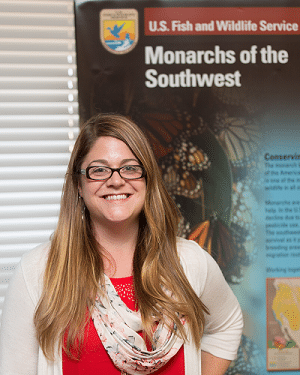Under the encouragement of the CPN Environmental Protection Department and support from fellow departments, Citizen Potawatomi Nation continues to play an integral role in Indian Country’s response to the devastating losses to Monarch butterfly populations in Oklahoma.
“CPN makes an effort to be good stewards of the environment,” explained Arthur Muller, director of the tribal environmental protection department. “In Oklahoma, so much of our economy is reliant on agriculture, which itself is reliant on pollinators like the Monarch butterfly, it is important to protect them.”
Due in large part to the use of pesticides that kill off native milkweed, which are the Monarch’s main source of food, butterfly populations have been decimated in recent decades. In Feb. 2016, CPN hosted a community garden workshop. The USDA Natural Conservation Service’s Carol Crouch, Ph.D. spoke on the reasons for and solutions addressing the loss of the Monarch’s habitat.
In March 2016, the momentum continued with experts from across the central and southwest U.S. travelling to CPN for a two day Monarch butterfly conservation and coordination training session.
“The tribes of Oklahoma can make a huge difference by shifting some of their land management practices to attract the butterflies by planting patches of lost milkweed from the lands. The huge representation of the tribes at this workshop demonstrated that the tribes of Oklahoma want to make a difference,” said Crouch.
 Katie Latta from the U.S. Fish and Wildlife Service was one of the conference’s attendee. Latta is the Monarch butterfly outreach specialist for Texas and Oklahoma who liaises with tribes in both states to promote conservation opportunities.
Katie Latta from the U.S. Fish and Wildlife Service was one of the conference’s attendee. Latta is the Monarch butterfly outreach specialist for Texas and Oklahoma who liaises with tribes in both states to promote conservation opportunities.
“I hope we can come up with some good projects for creating or enhancing Monarch habitats throughout Oklahoma on tribal lands,” said Latta.
She explained that the driving cause of the Monarch butterfly’s loss in population is habitat loss in locations where they breed, like the southern U.S., as well as their wintering habitats in northern Mexico.
“We’re trying to address that by delivering conservation on the ground that can create or enhance those habitats,” said Latta. “The goal of the workshop was to engage tribes in Monarch conservation projects. Essentially, these are land management projects that will encourage growth and abundance of the plants Monarchs depend upon throughout the landscape.”
After consultations with experts like Latta and Crouch, the tribe’s efforts at revitalizing the Monarch’s habitat are already underway. The annual community garden, located at the CPN Eagle Aviary, is working towards phasing out all pesticides that harm the butterflies. Garden volunteers will also plant pollinator-friendly crops to provide a safe haven for the butterflies.
“The average person can make a difference in their own back garden. I feel the workshop elevated the awareness that the Monarch incredible migration pathway is at risk and that everyone can help make a difference,” concluded the USDA’s Crouch.
With continued awareness across Oklahoma, the hope is that tribal nations can continue to provide a leading example for the rest of the state for best approaching such an important, but delicate creature.
To learn more about statewide efforts at protecting the Monarch butterfly, visit www.nativebutterflies.org or visit the CPN Community Garden Facebook page at cpn.news/garden.
